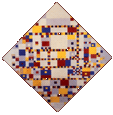
|
In Holland he met important collectors, befriended philosophers and fellow artists, and developed his philosophy of Neo-Plasticism as he was to call his abstract art. Over the next two decades he published many articles about this philosophy. When the war as over, Mondrian, then 47, returned to Paris. His work showed a radical transformation. His Neo-plastic painting had a “dynamic balance” of blocks of pure primary colors with black lines dividing planes of pure whites or grays. The rhythms of modern music, jazz and tango were strong influences. In 1925, after several years of hardship, his recognition began to grow. His paintings were purchased by many collectors and shown in Europe and America. In 1938 with the threat of war, he moved to England and in 1940 moved to New York. At this time, the black lines in his paintings were replaced with colored lines and lines formed of blocks of color. In Victory Boogie Woogie, the last painting before his death in New York in 1944, small blocks of color dance all over the surface of the painting. In 1945 the Museum of Modern Art held a retrospective which acknowledged his place in history of modern art. |
|
|

Victory Boogie Woogie (unfinished) 1942—1944
|
|||
|
|
| ← | Page |
| © 2002—2025 Mondrian/Holtzman Trust. All rights reserved. | Web Design by Enterprise Computer, LLC |